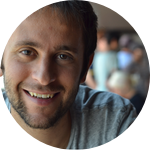About This Project
Can an array of one hundred satellite thrusters be smaller than a penny? Formations of pico-satellites (satellites the size of a softball) are the future of space technology but require of a propulsive system that provide significant thrust efficiently and in a controllable manner. The goal of this project is to obtain this propulsive system micro-fabricating an array of one hundred colloid thrustersAsk the Scientists
Join The DiscussionWhat is the context of this research?
Electric propulsion is a reliable technology that provides highly efficient and controllable thrust for satellites. However, a large range of space missions require a much higher total thrust. Our final goal is to build a system able to deliver one hundred times the propulsive force of traditional electric technology while keeping it controllable and efficient.
In our laboratory we work with a technology called colloid thrusters. We have successfully miniaturized one of these; our next step is to fabricate an array of 81 thrusters that are reliable, small and light enough to be used in a microsatellite.
What is the significance of this project?
Space technology is evolving towards smaller and lighter satellites. In the near future we will see swarms of satellites flying in formation while collaborating between them to fulfill their missions.
The small total thrust output provided by colloid thrusters makes them the ideal choice to control the upcoming generation of micro, nano and picosatellites but limits their use to missions with small propulsive requirements.
Current technological alternatives that provide high thrust are too bulky, heavy or difficult to control. Microfabricated arrays of colloid thrusters are small and light enough to fit on a penny.
What are the goals of the project?
I've already started working on this project for my PhD. The collected funds will be used for materials purchase, travel expenses and the use of the INRF (UCI) and Nanolab (UCLA) cleanrooms. Cleanrooms provide a controlled environment, free of dust and particles in suspension; this is an essential requirement to build the microscopic array of thrusters for my research.
Cleanroom fees are the major expense of the project and include the usage of the equipment necessary to transfer the desired geometries into a silicon wafer. Some of the machinery used are DRIE (Deep Reactive Ion Etcher), RIE, Mask aligners and SEM (Scanning Electron Microsope)
Budget
The main technique used for this project is photolithography, similar to screen printing and traditional film development. The process is the following: Silicon wafers are covered with photoresist (a photosensitive rubber) and later exposed under a UV lamp. Between the wafers and the lamp we place a mask with the desired micro-pattern to transfer; then the photoresist is developed in a process similar to traditional photography resulting in a wafer covered with a layer of protective rubber in the areas unexposed to the UV light. Finally we use a Reactive Ion Etcher to carve silicon from all the unprotected areas.
A Scanning Electron Microscope (SEM) is used to check the results. To avoid contamination by dust or suspended particles work is done in the controlled environment of a cleanroom.
Meet the Team
Affiliates
Mechanical Engineering (5 year degree), Barcelona Tech - Universitat Politecnica de Catalunya
Masters in Aerospace Engineering, University of Padua (Italy)
Team Bio
Born and raised in Barcelona (Catalonia) I have been living in California for the last 5 years.Before arriving to the USA I obtained a TIME (Top Industrial Management for Europe) double degree in Mechanical and Aerospace Engineering from Barcelona Tech (UPC-Catalonia) and the University of Padua (Italy). From 2009 to 2012 I have been recipient of the Balsells Fellowship to pursue my doctoral studies at the University of California Irvine.
Enric Grustan
Born and raised in Barcelona (Catalonia) I have been living in California for the last 4 years.
Before arriving to the USA I obtained a TIME (Top Industrial Management for Europe) double degree in Mechanical and Aerospace Engineering from Barcelona Tech (UPC-Catalonia) and the University of Padua (Italy). From 2009 to 2012 I have been recipient of the Balsells Fellowship to pursue my doctoral studies at the University of California Irvine.
Lab Notes
Nothing posted yet.
Project Backers
- 7Backers
- 20%Funded
- $485Total Donations
- $69.29Average Donation

